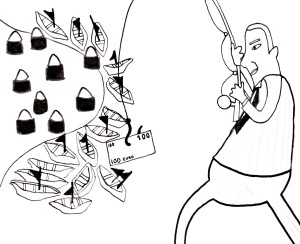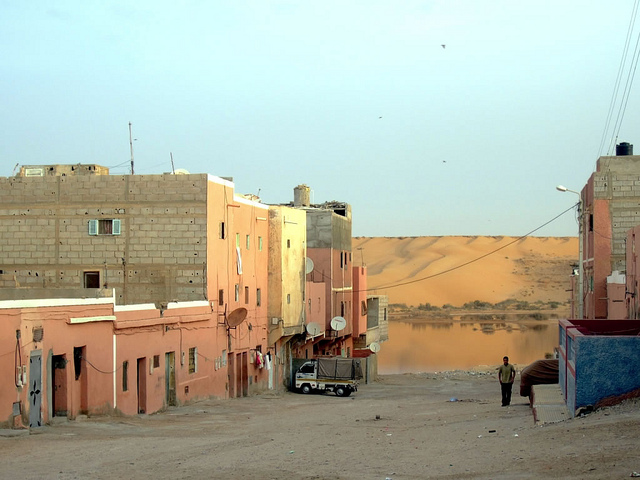Situated 260 miles south of Agadir, one of Morocco’s serene beach town, is the starting point of the Moroccan Wall, a sand barrier bisecting the contentious territory of Western Sahara. On one side of the wall lie areas of Western Sahara that have been under Moroccan rule since 1976; Africa’s last colony is a zone rife with human rights abuses, natural resource exploitation, and international law violations. On the other side of the wall is the self-proclaimed Sahrawi Arab Democratic Republic (SADR), a 40-year-old state established by the Polisario Front, a liberation coalition that has pursued full independence for the native Sahrawi population for years to no avail. Instead, Morocco’s government has further entrenched itself in the highly profitable region, wielding Western Sahara’s myriad resources in negotiations with international trade partners to quench the country’s thirst for foreign currency. But the North African country’s actions may violate international law, and as foreign actors begin to divest, the government must confront the economic ramifications of remaining in Western Sahara.
For decades, Western Sahara has been under the rule of external entities. In 1973, the Sahrawis created the Polisario Front to end Spain’s nearly century-long colonization. Two years later, despite the International Court of Justice’s ruling in favor of Sahrawi independence, Morocco’s King Hassan II seized the land from Spanish hands. The Front continued its resistance, and in 1991 the UN brokered a peace agreement between the two parties after a 16-year-long insurgency. Soon after, the UN Mission for the Referendum in Western Sahara scheduled a vote on Sahrawi independence, but Morocco’s position on Sahrawi enfranchisement prevented the ballot measure from reaching voters.
 At its core, strategic economic interests underlie Morocco’s unwillingness to abandon Western Sahara. The region contains highly profitable natural resources — most notably, phosphates and fishing reserves. In fact, more than three-fourths of the world’s phosphate comes from Morocco and Western Sahara. Each year, the phosphate-rich Bou Craa mine in Western Sahara — owned by the Moroccan Office Chérifien des Phosphate (OCP), the leading global phosphate exporter — attracts major international investors, including PotashCorp, the world’s largest fertilizer company. Moreover, Morocco’s access to fishing reserves near Western Saharan shores has led to several trade agreements with the EU, Russia, and Japan, among other nations. The Moroccan government has reaped benefits from exporting the region’s sand to areas like the Canary Islands and encouraging foreign actors to explore Western Sahara’s potential untapped oil reserves.
At its core, strategic economic interests underlie Morocco’s unwillingness to abandon Western Sahara. The region contains highly profitable natural resources — most notably, phosphates and fishing reserves. In fact, more than three-fourths of the world’s phosphate comes from Morocco and Western Sahara. Each year, the phosphate-rich Bou Craa mine in Western Sahara — owned by the Moroccan Office Chérifien des Phosphate (OCP), the leading global phosphate exporter — attracts major international investors, including PotashCorp, the world’s largest fertilizer company. Moreover, Morocco’s access to fishing reserves near Western Saharan shores has led to several trade agreements with the EU, Russia, and Japan, among other nations. The Moroccan government has reaped benefits from exporting the region’s sand to areas like the Canary Islands and encouraging foreign actors to explore Western Sahara’s potential untapped oil reserves.
Consequently, Morocco has directed a large part of its national budget to developing Western Sahara. In early February 2016, the state-owned OCP launched a $1.85 billion plan for a new fertilizer plant, port, and phosphate industrial facilities in the region. OCP also regularly contributes to housing and healthcare programs to enhance infrastructure. But regardless of such heavy investment, relatively little of it benefits the local Sahrawis, who experience a high unemployment rate. These circumstances — in addition to human rights abuses — often propel many Sahrawis to the refugee camps of Tindouf, Algeria, where malnutrition and deleterious health conditions plague the displaced natives. Instead, the perks of investment go to Western Sahara’s Moroccan settlers, who are drawn to the region by the promise of land, subsidized food, and lower taxes.
Morocco’s dominion over Western Sahara hasn’t gone unnoticed by the international community. The country has been accused of violating an international law that prohibits occupying powers from exploiting a territory’s natural resources unless development serves the best interests of the local population. In December 2015, the EU Court of Justice annulled a 2012 farm trade pact that “expanded duty-free status to dozens of Moroccan agricultural and fisheries products imported to the EU.” Brought forth by the Polisario Front, the case decided that the pact impinged upon Sahrawi rights and the SADR’s ownership of its natural resources. In February, although the EU decided to appeal the decision, Morocco still suspended ties with the union, rejecting the case as an outright violation of international law.
Despite damaging economic consequences, the government continues to suppress dissident voices that criticize Moroccan actions in Western Sahara. In mid-March, the country ordered the UN to evacuate all 84 of its members from Western Sahara after Secretary General Ban Ki-moon referred to the situation as an “occupation” during a recent visit, drawing the ire of the Moroccan government. But today, over 84 states already recognize the SADR as an independent nation — several of them fostering diplomatic relationships — and Morocco’s unwillingness to budge from the region may have increasingly detrimental economic costs. In 2015, EU-Morocco farm trade amounted to $4.6 billion, and the sudden suspension of trade could disrupt about $1.12 billion in EU grants. Moreover, some countries that have publicly supported the SADR’s sovereignty have even instituted regulations for corporations affiliated with Morocco’s exploitation of Western Sahara. Not only has Norway divested from PotashCorp — Bou Craa’s most loyal customer — but it also fines any Norwegian vessels operating in Western Saharan waters. With greater divestment, Morocco may find itself friendless in the near future.
As of yet, no amount of international pressure has mitigated the kingdom’s territorial tantrums. But the EU Court’s decision and Ki-moon’s controversial visit have already begun to catalyze further international action and amplify dissident voices, incurring higher economic costs for Morocco. This global scrutiny, coupled with the Polisario Front’s relentless political fight, may be just enough to bury Morocco deeper in the sand.
Art by Soraya Ferdman
